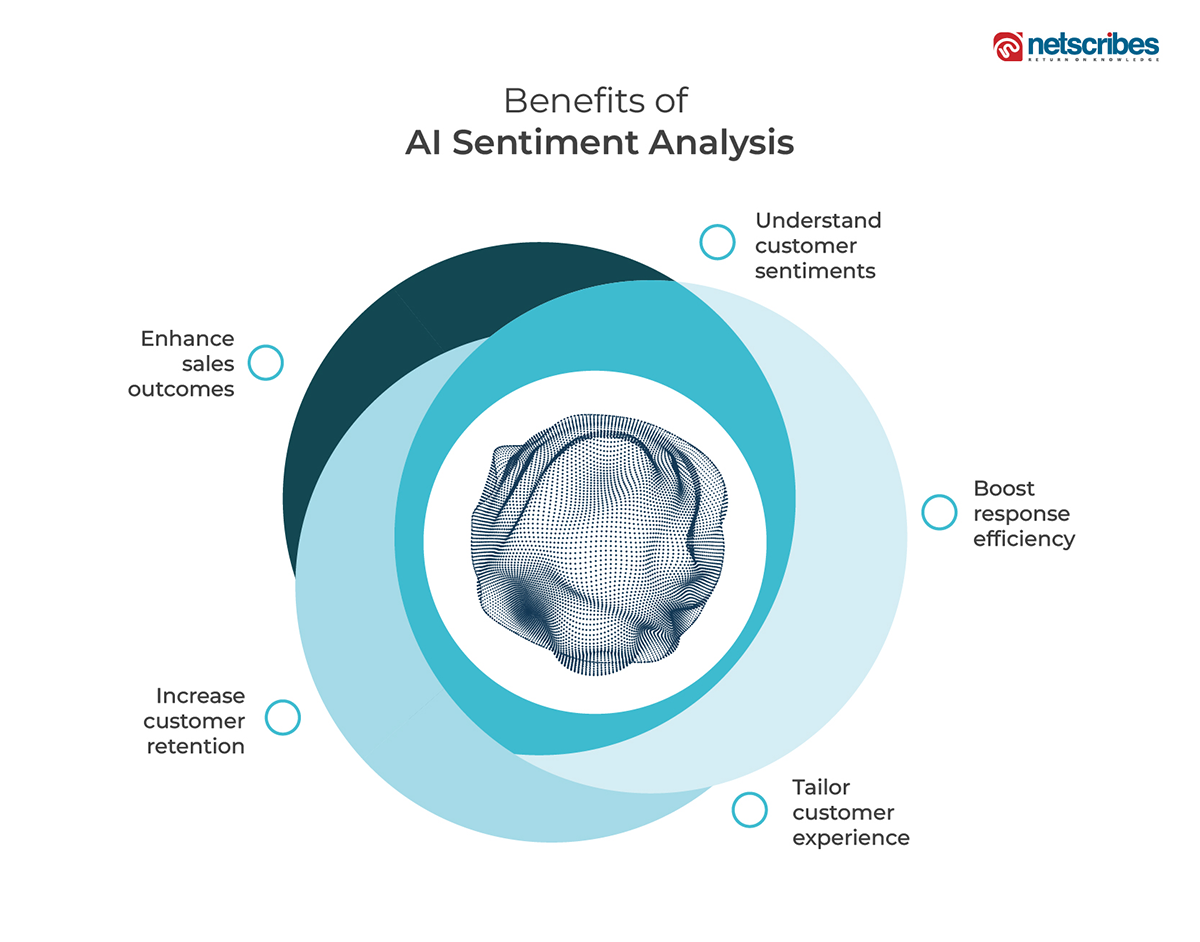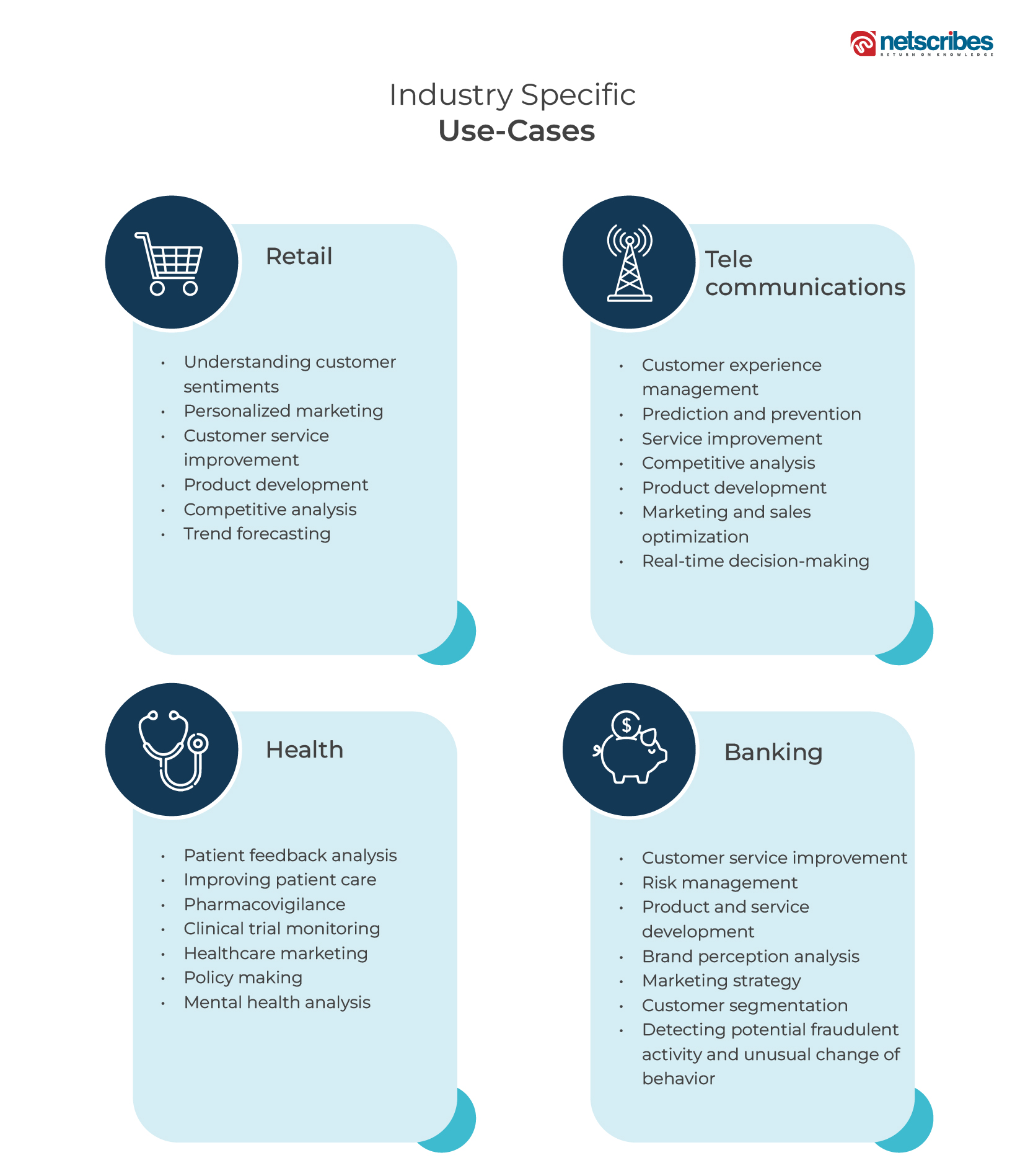Artificial Intelligence (AI) in sentiment analysis and industry use cases

Highlights:
Highlights
- AI tools help businesses process large volumes of data to gain real-time insights into customer sentiments.
- Major industries like finance, healthcare, and travel utilize AI sentiment analysis to optimize strategies and improve customer experiences.
- Examples include IBM using sentiment analysis in their Watson suite and Amazon leveraging customer reviews to influence product development.
- Benefits to businesses include enhanced brand perception, targeted marketing, and proactive customer service strategies.
- Contextual understanding limitations, privacy concerns, and biases in AI models are the major challenges.
Consumers today are highly vocal about their experiences with products and services, thanks to online platforms such as social media, online reviews, and customer support interactions. The data collected from these platforms can be beneficial for companies to understand their customers’ sentiments. However, the high volume of such unstructured data can be overwhelming and is almost impossible to process manually. Can AI be the game-changer in this case? In this article, we shall understand the application of AI in sentiment analysis and its use cases in various business sectors.
What Is AI-based Sentiment Analysis?
AI-based sentiment analysis is the process of analyzing large volumes of digital text input using Natural Language Processing (NLP) techniques to determine the emotional context of the text. Sentiment analysis is a subset of AI. Sentiment analysis tools scan the input to identify keywords and score each keyword based on the emotion associated with it. Based on the score, the sentiment of a sentence can be labeled as positive, negative, or neutral. There can also be a ”mixed” sentiment label, with no score. Consequently, the overall sentiment of a document with multiple sentences is determined by aggregating the sentence scores.
Why Do We Need AI-based Sentiment Analysis?
Customer feedback is a critical resource for understanding what works and what needs improvement. Traditionally, companies used surveys and focus groups to understand customers’ sentiments toward their products. However, given the large volume of customer feedback available through various touchpoints, manually checking and evaluating this feedback can be incredibly complex and time-consuming.
With the advent of big data analytics, organizations have started using AI-based tools to process large volumes of data to gain a more accurate understanding of customer opinions. AI-based sentiment analysis produces objective insights at scale and in real time.
To illustrate an example of real-time sentiment tracking, let us consider the example of a customer support chatbot conversing with a customer. Based on the keywords from the customer’s messages, the emotional context of the conversation is identified. Once the emotions are traced, AI chatbots and virtual assistants can assess customer sentiment in real time and tailor responses accordingly. For instance, if a customer expresses dissatisfaction in their feedback, an AI-powered chatbot can be trained to respond with empathy and understanding, offering solutions that align with the detected sentiment. This information can further be used to assist and train chatbots to provide more human-like experiences.

Benefits to Businesses
Monitoring and understanding brand perception is critical for businesses, and artificial intelligence has revolutionized this process. Businesses can use the insights derived from sentiment analysis to tweak their strategies according to market trends and customer preferences. Applying AI-powered sentiment analysis to market research produces accurate results at scale. It gives companies a comprehensive view of how customers perceive their services or products.

Examples of implementing AI in Sentiment Analysis
- Social media analysis: AI-powered tools can analyze social media conversations and identify trends and shifts in customer sentiment related to specific products, brands, or industries. For example, companies can track brand mentions on Twitter to track opinions shared by the public and identify emerging trends. For example, in the case of a restaurant, aspects might include “food quality,” “ambiance,” or “service speed.”
- News and content analysis: AI can process vast amounts of news articles and online content to detect emerging topics, keywords, and changes in sentiment within specific industries. Businesses can use this information to stay updated on the latest market trends and adapt their strategies accordingly.
- Customer behavior analysis: This analysis helps reveal patterns in consumer behavior by examining large datasets of customer interactions, purchasing histories, and online activity. The ability to predict customer behavior can help businesses plan effective marketing and communication strategies and make informed decisions.
AI-driven sentiment analysis can assess whether a brand’s messaging aligns with customer perceptions. This alignment check empowers companies to refine their communication strategies, adopt a customer-centric approach, and cultivate a brand image that genuinely connects with its audience. Let us explore how major companies worldwide have applied AI-based sentiment analysis in their business.
Use Cases
- IBM includes sentiment analysis as part of its Watson suite of services. These services are widely used across industries such as finance and healthcare.
- Amazon uses sentiment analysis to meticulously examine a vast collection of customer reviews. By leveraging this advanced analysis, Amazon gains invaluable insights that directly influence its product development strategies. To convert customer insights into action, Amazon divides the process into several actionable steps. They prioritize enhancing products that align with customer preferences, ensuring that future iterations maintain or amplify these strengths. Amazon’s use of AI for sentiment analysis shows how businesses can enhance their product development efforts by actively understanding customer feedback.
- UnitedHealth Group, a renowned healthcare company, employs sentiment analysis to gauge employee sentiments through feedback surveys. This enables them to gain valuable insights into employee perspectives on workplace conditions, management, and benefits. Identification of areas where employees express dissatisfaction empowers UnitedHealth Group to proactively address these concerns and promote a happier and more engaged workforce. This positively impacts the quality of care provided to customers
- Airbnb, a leading player in the global travel industry, utilizes generative AI sentiment analysis to closely monitor interactions between guests and hosts. This involves analyzing the sentiments expressed within guest reviews and messages exchanged between users. By doing so, Airbnb identifies issues and concerns in real time.

Challenges with sentiment analysis
Although being a useful tool, sentiment analysis presents some unique challenges also to the users.
- Contextual Understanding: AI sometimes struggles to grasp the context of language, leading to misinterpretations of sentiments. This is particularly challenging when dealing with sarcasm, irony, or cultural nuances.
- Dataset Privacy: Gathering and analyzing customer data for sentiment analysis raises concerns about data privacy and security.
- Bias: Humans can incorporate biases in training data, which AI models may follow. This can lead to unfair results. Efforts are underway to reduce bias and ensure fairness in sentiment analysis.
Conclusion
AI-based sentiment analysis enables businesses to gain a deeper understanding of their customers, enhance brand reputation, and optimize products and services. It offers accurate real-time insights, identifies growing trends, and facilitates data-driven decision-making. However, it also presents practical concerns such as bias, privacy, and contextual understanding issues. Overall, we can confidently say that AI sentiment analysis can be a game-changer in the efforts to improve user experience. Hence, understanding the possible applications of sentiment analysis in your domain can be enriching. Embracing these innovations will be immensely useful in enhancing customer experiences, which ultimately gives a competitive edge.
Explore how Netscribes’ Technology Solutions can help you leverage AI-based sentiment analysis to understand your customers and their buying behavior better. Contact us today for a demo.
FAQs
What is sentiment analysis?
Sentiment analysis is a subset of AI. Sentiment analysis is the process of analyzing large volumes of consumer feedback data to determine its emotional context. Upon analyzing the feedback, it is classified as positive, negative, or neutral.
How is Sentiment analysis useful for businesses?
Sentiment analysis helps businesses to understand what their customers think about their products and services. This understanding will help them address customer pain points and tweak their offerings to the satisfaction of their customers. It also helps in increasing the efficiency of marketing campaigns and improving sales outcomes.
How is AI used in sentiment analysis?
The application of AI is critical in processing huge volumes of data. Natural Language Processing (NLP) techniques and big data analytics are used to analyze keywords in customer reviews and to determine the emotional undertones in the text.
What are the advantages of AI-based sentiment analysis over traditional methods?
AI technology has an edge over traditional methods in analyzing data analysis. AI-based sentiment analysis processes large volumes of data in much less time, reduces costs significantly, and improves decision-making precision.
What are the limitations of using AI in sentiment analysis?
NLP technique processes the keywords and determines the underlying sentiments based on the literal meaning. However, it has limitations in understanding the context of words. In addition, privacy concerns and biases in AI models introduced by human programmers are the major challenges.






